Recently developed RFID tags are becoming gradually more accessible to the masses, but do the benefits of this technology outweigh its initial expense.
 Track-and-trace technology enables users to locate and identify items throughout the supply chain. Methods adopted for such purposes on the returnable transit packaging used for moving automotive components range from simple barcode labels with unique reference numbers, to more sophisticated radio frequency-identification (RFID) systems. Indeed, there is a large RFID tracking project underway in North America right now, managed by packaging specialist Surgere (whose executives were unavailable to comment for this story).
Track-and-trace technology enables users to locate and identify items throughout the supply chain. Methods adopted for such purposes on the returnable transit packaging used for moving automotive components range from simple barcode labels with unique reference numbers, to more sophisticated radio frequency-identification (RFID) systems. Indeed, there is a large RFID tracking project underway in North America right now, managed by packaging specialist Surgere (whose executives were unavailable to comment for this story).
Beyond Surgere, a number of other manufacturers and packaging companies are also looking to improve the visibility of their equipment, using scanning technology as well as mobile and web-based applications. Experts suggest that most supply chains require just such a mixed approach to manage their tracking needs.
By and large, much of the tracing of packaging still follows decidely 20th century practices. According to Kevin Wade, inbound logistics and supply chain manager at Honda North America, although simple barcode-based track-and-trace technology has been routinely used in inbound logistics systems for many years, the proper management of the return flows of packaging back to suppliers is a “whole different situation”. Many OEMs typically revert back to manual, non-integrated shipment control methods and returnable container ‘bill of lading’ processes are often used to manage these return flows, with the assumption that this method will move the containers to the proper supplier.
Like other OEMs, Honda has created portal-based tracking systems that project the movement of packaging. It also uses simple returnable container labels with a ‘licence plate’ barcode to enable transactions to flow through the scanning and management applications its 3PLs use at crossdocks.
“The primary packaging we are tracking at the moment is any returnables flowing through our crossdock collection-route transportation network,” says Wade. “This provides error-proofing to the crossdock change of processes and confirmation of the returnables’ movement to the proper outbound transportation route.
“In addition to the crossdocks, the addition of highly visible, human-readable container destination labels, along with a semi-intelligent barcode [ensures that] each of [our] supplier dock workers within a transportation collection route can clearly understand which containers are to be removed at their respective supplier location.”
Looking ahead, Wade is also confident that combining the use of barcode or RF tags in returnable packaging with the creation and transmission of advance shipping notices (ASN) that link the returnable containers, will enable OEM supply chain partners to manage containers “as if they are parts”.
“The main advantage of track-and-trace technology within the automotive supply chain is that it provides the ability to confirm expected delivery events and enables error-proofing for all the logistics service providers that are involved in the returns processes,” he says.
Secure tracking with RFID
Jim Hardisty, managing director at Goplasticpallets, agrees that the continued use of barcode-based technology alone is limiting and not appropriate to deal with more sophisticated automotive supply chains.
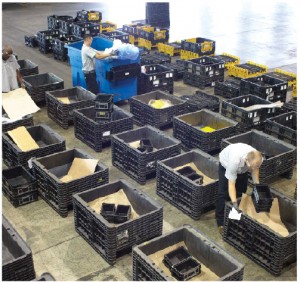
Hardisty also points out that RFID tag technology has advanced a great deal in the last few years, with a variety of options now available, ranging from lower cost, battery-powered active RFID tags, to more high-tech, passive RFID tags that draw their power from radio waves transmitted by a reader.
“Until recently, economic limitations and technology have restricted the use of RFID technology to high-value assets such as finished goods and major assemblies, but developments in active and passive RFID tags have opened the door to much wider usage,” says Hardisty.
Goplasticpallets’ automotive customers use two types of chips when shipping goods on its pallets, namely read-only and read-write RFID tags.
“Read-only chips are pre-programmed with a unique number plate, which cannot be changed, where read-write chips allow for users to add information to the RFID tags or write over existing information,” says Hardisty. “The tags can be read using gateway readers or handhelds linked to tablets and even mobile phones,” he adds.
Ford is one company that makes use of both active and passive RFID tags, integrating the technology into specially designed containers that it says are vital to its manufacturing processes. According to Franko Bayer, packaging engineering supervisor at Ford, the particular solution used must be tailored to the specific need within the manufacturing process, which includes support for specific sheet metal press runs, the location of specific part or serial numbers within material flow processes, and the validation of transport assumptions used within rack fleet-size calculations.
“Any track-and-trace solution has to balance the total landed cost of deploying the technology with the benefit or cost savings to the manufacturing process,” Bayer says. “Fully or semi-automated rack-tracking processes provide quick information, which in the past took lengthy labour-intensive investigations and inventories.
"A robust system would include accurate inventories at all nodes of the supply chain to include in-transit quantities. Such a system could generate reports and facilitate proactive notifications of packaging-related events" - Eric Swanson, Orbis
“The usage of this information enables a faster decision-making process, especially for production support or part monitoring within the supply chain. All these efforts have to be evaluated with the cost to deploy the required system infrastructure and software.”
Benefits of a robust system
In recognition of the role that the active tracking of reusable packaging has in helping companies to reduce operating expenses and improve packaging utilisation, container-pooling services company Chep uses a range of cutting-edge software and hardware to optimise its tracking capabilities.
Thorben Steinke, marketing communications manager at Chep, explains that the approach used can vary from manual keyboard data entry and barcode scanning to passive UHF RFID- and EDI- (electronic data interface) based systems. The company has also successfully launched a GPS-based container-tracking solution in its aerospace business.
Steinke says the company currently tracks its more expensive assets, including plastic folding large containers (FLC), metal ‘autoboxes’ for the standard automotive supply chain and ‘securetainers’, plastic containers with a fixed lid for the aftermarket parts supply chain.
Eric Swanson, director of project management at Orbis Corporation, agrees that the technology used to track and trace container inventories tends to vary depending on the systems and processes employed. Orbis offers customers what Swanson calls “reusable packaging management services” to manage the reverse logistics of reusable packaging. It also provides a proprietary system called SmartTrak, designed specifically to manage reusable packaging assets for customers that do not possess their own tracking capabilities.
“We manage all types of reusable packaging including pallets, bulk bins, hand totes with and without dunnage and metal racks for automotive,” says Swanson.
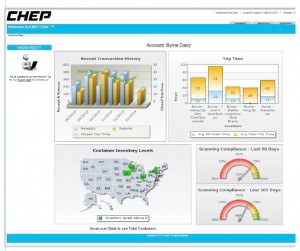
For Swanson, the most common benefits of actively tracking reusable packaging include reduced transport costs – made possible by the matching of container supply to demand – and an increase in the ability to make more intelligent decisions about deployments.
“Other advantages include reduced theft, breakage and loss by holding users accountable for your packaging assets and inventories [as well as] reduced labour costs, with fewer production line disruptions due to packaging stock outs,” Swanson says.
“The only disadvantage would be the cost of administering the programme. It is important that the cost of the technology does not offset the benefits of the programme. Any tracking technology solution should be scaled to the size of the packaging fleet to be managed,” he adds.
According to Steinke, the use of track-and-trace technology in packaging systems can also help to improve the monitoring of parts and component inventory in transport or warehouses.
“As an example, if you track a unit load through the supply chain to collect data, you would have immediate visibility to the asset type, unique asset ID, information on which supplier it is being shipped to and from, component information, and any other information you choose to collect,” he says. “Again, the more points throughout your supply chain at which you opt to collect information, the more granular and valuable your data becomes.”
RFID-enabled packaging could provide additional benefits related to tracking part locations within the plant. However, tracking the parts further into the supply chain would require investment in readers by suppliers and third party logistics providers. RFID could also be used to confirm that the right part is being used in assembly or to reorder parts in real time as they are consumed, thinks Swanson.
Using a phased approach
Jim Hardisty at Goplasticpallets says the implementation of an RFID system is a “huge undertaking” and one that requires substantial planning over a considerable period of time. He also highlights the fact that choosing the best type of tracking system to use can be challenging since a method that might seem useful right now may not be the best long-term solution,
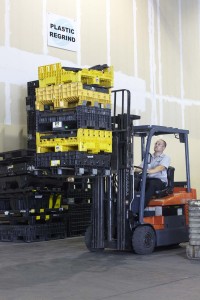
Automotive manufacturing plants are naturally rich in metal, which can cause significant problems for RFID transponders. According to Hardisty, metal can reflect energy away from the tag and detune the tag antenna, preventing it from being picked up by the reader. But there are now tags available with spacers that can be placed on metal objects, such as nuts and bolts, for example.
Steinke agress that, when deployed in an environment with a lot of metal, such as in the automotive supply chain, the use of UHF RFID technology can be problematic. He adds that another challenge in the use of track-and-trace technology relates to the necessary change-management process. For an asset tracking programme to be successful, he believes it is critical to ensure ‘key stakeholder alignment’ by identifying and engaging all the key players involved – including corporate HQ staff, plant workers and suppliers – and ensuring that everyone receives ongoing communication throughout the implementation process.
“Educate your supply chain partners and be sure to inform team members of the value of asset visibility, including how it saves the company money by minimising asset loss and identifying supply chain bottlenecks to optimise fleet utilisation,” he says.
Eric Swanson says the efficient tracking of reusable packaging requires “process discipline” from all users in the supply chain. He believes carmakers that have operated with an unmanaged system for a long period of time may have a difficult time reining in the wasteful processes that tend to develop when supply chain partners have experienced availability issues with packaging. “For example, suppliers might keep excessive inventories from the OEM to protect themselves against outages; use packaging that belongs to other suppliers and OEMs; or not follow the standard packaging plan for each part,” he says. “We generally suggest that customers who are moving from an unmanaged system to a managed system start with a small group of disciplined suppliers to work out the new process, then launch with additional groups of suppliers, using a phased approach.”
Finding the perfect size
For Steinke, there is no ‘one-size-fits-all’ solution when it comes to asset management of the type achieved through track and trace. He believes a combination of technology and hardware often represents the best and most affordable option.
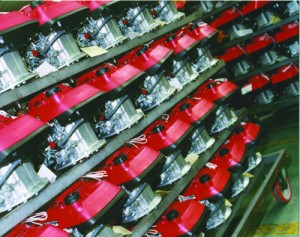
Honda’s Wade agrees that by taking advantage of existing automotive supply chain systems and business process, OEMs and their suppliers can easily implement simple “licence plate” accountability for returns.
However, he also argues that Honda has found the creation of barcodes and the individual scanning of every empty returnable container to be impractical. Instead, he says licence plate labels and scans occur at the single or multiple pallet scale and are linked with the exact number of containers or racks. Wade reveals that this “shippable unit” level process reduces the time required to provide an accurate listing of returns flowing through the reverse logistics networks.
“We still can’t justify the costs for RF technology with all the associated dock-readers and network across our entire supply chain. However, specific application of RF tags may be a benefit for high-volume large containers or racks, [where they] can confirm the contents entering the trailers from the reload process,” he says.
"Educate your supply chain partners and be sure to inform team members of the value of asset visibility, including how it saves the company money by minimising asset loss and identifying supply chain bottlenecks" - Thorben Steinke, Chep
In particular, Wade sees viability in such an application for suppliers shipping multiple trailer loads of product each day. Typically, these suppliers may need specific types of containers or racks to be shipped back to their facilities in a specific sequence rather than a simple first-in, first-out priority. Improved visibility priority and throughput time may reduce the packaging investment [and] could justify the RF tags, dock readers and supporting systems.
On balance, Swanson’s view is that the most cost efficient method to track packaging is to employ what he calls the ‘balance forward’, or ‘debits-credit’ approach, where a transaction of parts also results in a corresponding container transaction. Though he stresses that this requires the automotive company to enforce standard packaging guidelines.
“RFID gets a lot of attention and though the cost of tags has come down, the reader infrastructure is still costly if it is to be installed across the supply chain,” he says. “Unless the OEM can create additional value beyond tracking packaging, it would be an expensive solution. For example, why employ RFID to track packaging alone when the parts in the packaging have a value that far exceeds that of the packaging?”
Daniel Hettel, chief engineer of global material flow and packaging engineering at Ford, points out that a common misconception is that the right technology is based on the tag cost alone. In his view, the cost of installing the whole system infrastructure is also often a significant cost driver.
“Any solution should be tailored to specific need and should consider what existing technology is already deployed in order to identify potential synergies,” he says.
Evolution of track-and-trace
For Rodney Salmon, Europe and Middle East manager at Macro Plastics, one opportunity is the potential of track-and-trace technology to provide data relating not only to the type of pallet or container, but also to what is inside each of them.
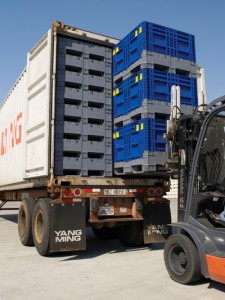
As the implementation of track and trace methods becomes more common and the cost of technology declines, Hardisty predicts that RFID will be used for all major automotive components. “The components will be tracked through the entire production process and recorded against the specific vehicle in which they’re used, achieving improved accuracy of inventories and tighter recall procedures,” he says.
On the operational side, Wade believes that over the next several years the industry will still likely be examining potential new technology while upgrading core systems, such as enabling the use of a returnable container ASN.
For now Steinke thinks there will be continued growth in implementing track and trace. “Much as it is today, I believe individual companies will continue to implement solutions to meet their specific requirements, while we are some time away from implementing systems standardised by our industry,” he says. “Once standards are adopted, we will start to see the evolution of track and trace from islands of knowledge to a genuine network of information gathering and sharing.”
There are growing signs that the rapid increase in the use of mobile technology such as tablets and smart phones is beginning to have an impact on the way companies track and trace material through the automotive supply chain.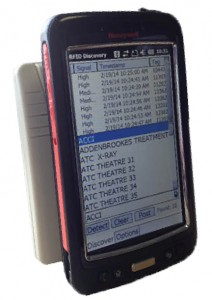
If the automotive industry can embrace standard business practices and platforms relating to returnable containers, Honda’s Kevin Wade suggests that all return ASN data could be mapped and uploaded into multiple third party logistics providers’ transport management systems. In view of the fact that most TMS applications have web-based user interfaces, he also says that the use of mobile technology could help to provide critical event alerts to key logistics personnel, regardless of their location.
“Ultimately this will enable logistics professionals to readily enact countermeasures, move the containers through alternative transit modes and ideally prevent supplier downtime or generate the use of expendable packaging,” he adds.
Ford’s Daniel Hettel agrees that mobile devices will play a greater role in the future, since live updates and reports will not depend on desktop computers.
Jim Hardisty at GoPlasticPallets points out that mobile devices have “revolutionised” the options to read and write to RFID tags over the last few years. “They are no longer restricted to gateway readers and can be checked and read for location finding, as well as the normal full recording requirements. So, if you can’t find the pallet of components you need, you can hunt it down.” he says.
Considering that most tracking hardware is now fully GSM, Wi-Fi and GPS capable, Chep’s Thorben Steinke also highlights the fact that the mobile network is already playing a huge part in asset management, particularly as it relates to data transmission. “The quicker you get data the more effective your track-and-trace solution is. Additionally, with most ‘smart’ devices, including barcode reading and ‘near field scanning’ capability, it is highly likely your technologies will work together,” he adds. “Whether this will in fact signal a ‘step change’ in the field of track and trace, only time will tell, but the signs are promising.”

























![Global[1]](https://d3n5uof8vony13.cloudfront.net/Pictures/web/a/d/s/global1_726550.svgz)









